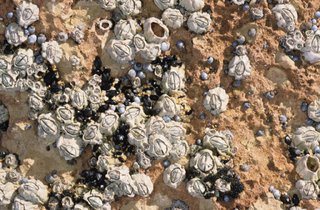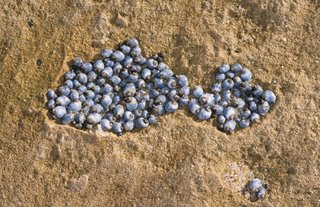 I like to head down to the coast SW of Melbourne whenever I can. (Not as often as I'd like, though.) The rock platforms at Barwon Heads* are always fun for a bit of rock-pooling.
I like to head down to the coast SW of Melbourne whenever I can. (Not as often as I'd like, though.) The rock platforms at Barwon Heads* are always fun for a bit of rock-pooling. Sometimes you have to make an effort to spot animal life on the shores. Especially at this time of year with the wind howling in from Bass Strait, making your eyes water and your nose stream. (It's not a good look. Or it wouldn't be, if you could see.)
 Many organisms (animals and algae) occupy specific ranges on the shore, usually identified by distance from low tide level. For most species, the upper limit of the range depends on the way it handles exposure to air. Not all organisms can deal with the problem effectively but those organisms that live at or above high tide level have efficient ways of avoiding desiccation. They seal off their shells, clamp themselves to rocks, hide under stones or cluster together. Barnacles close their plates, preventing water loss from their bodies. Mussels close the two valves of their shells.
Many organisms (animals and algae) occupy specific ranges on the shore, usually identified by distance from low tide level. For most species, the upper limit of the range depends on the way it handles exposure to air. Not all organisms can deal with the problem effectively but those organisms that live at or above high tide level have efficient ways of avoiding desiccation. They seal off their shells, clamp themselves to rocks, hide under stones or cluster together. Barnacles close their plates, preventing water loss from their bodies. Mussels close the two valves of their shells.  Littorinid snails block the opening of their shells with a plate-like operculum. They also nestle against one another and glue themselves to a hard surface. Just to make sure.
Littorinid snails block the opening of their shells with a plate-like operculum. They also nestle against one another and glue themselves to a hard surface. Just to make sure.Whereas the upper limit is determined by physical factors, the lower limit of a range is influenced by competition for food and space and by predation. There's not a lot of peace and harmony in nature.
*yes, where they filmed Seachange.